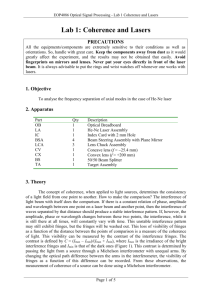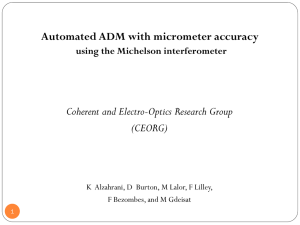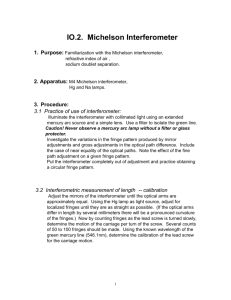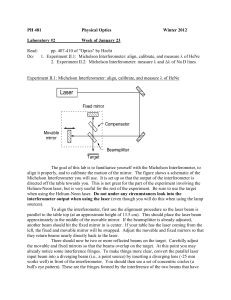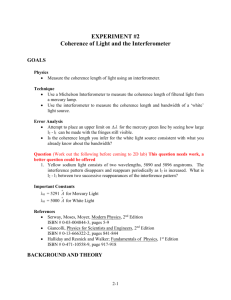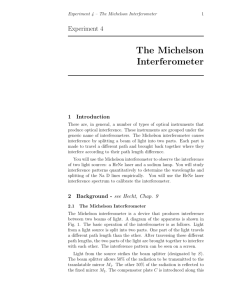Division of Amplitude Interferometry
advertisement
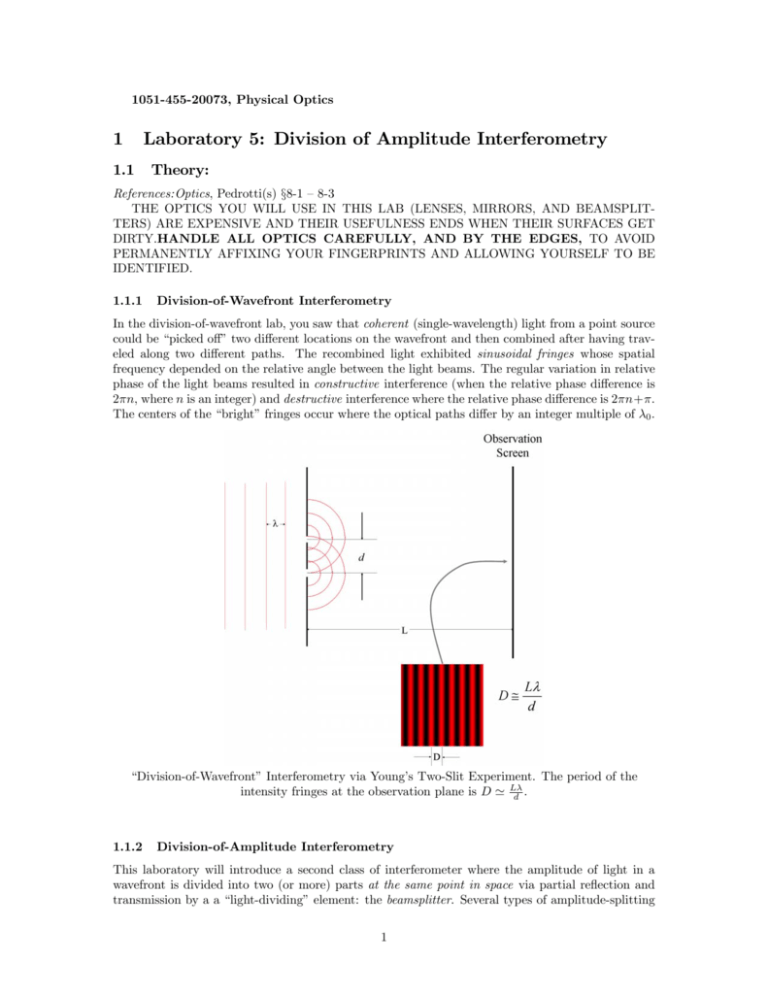
1051-455-20073, Physical Optics
1
Laboratory 5: Division of Amplitude Interferometry
1.1
Theory:
References:Optics, Pedrotti(s) §8-1 — 8-3
THE OPTICS YOU WILL USE IN THIS LAB (LENSES, MIRRORS, AND BEAMSPLITTERS) ARE EXPENSIVE AND THEIR USEFULNESS ENDS WHEN THEIR SURFACES GET
DIRTY.HANDLE ALL OPTICS CAREFULLY, AND BY THE EDGES, TO AVOID
PERMANENTLY AFFIXING YOUR FINGERPRINTS AND ALLOWING YOURSELF TO BE
IDENTIFIED.
1.1.1
Division-of-Wavefront Interferometry
In the division-of-wavefront lab, you saw that coherent (single-wavelength) light from a point source
could be “picked off” two different locations on the wavefront and then combined after having traveled along two different paths. The recombined light exhibited sinusoidal fringes whose spatial
frequency depended on the relative angle between the light beams. The regular variation in relative
phase of the light beams resulted in constructive interference (when the relative phase difference is
2πn, where n is an integer) and destructive interference where the relative phase difference is 2πn+π.
The centers of the “bright” fringes occur where the optical paths differ by an integer multiple of λ0 .
“Division-of-Wavefront” Interferometry via Young’s Two-Slit Experiment. The period of the
intensity fringes at the observation plane is D ' Lλ
d .
1.1.2
Division-of-Amplitude Interferometry
This laboratory will introduce a second class of interferometer where the amplitude of light in a
wavefront is divided into two (or more) parts at the same point in space via partial reflection and
transmission by a a “light-dividing” element: the beamsplitter. Several types of amplitude-splitting
1
interferometers are used: the Michelson (in this lab), Twyman-Green (a Michelson with a collimated
input beam), Mach-Zehnder, Sagnac, and Fabry-Perot interferometers. All have their particular
applications in optics and metrology (the science of measurement).
This lab demonstrates the action of the Michelson interferometer for both coherent light from a
laser and for white light (with some luck!).
Coherence of a Light Source If two points within the same beam of light exhibit a consistent
and measurable phase difference, then the light measured at two points in space at the same time,
or at the same point in space at two different times, is said to be coherent. Light with such a
definite phase relationship may be combined to create measureable interference (constructive and
destructive). The shape or action of the resulting interference fringes is determined by the shapes
or actions of the interfering wavefronts and therefore describes the wavefronts.
The ease with which fringes can be created and viewed is determined by the quantitative coherence
of the source, which often is measured as the coherence length coherence (measured in meters) This is
the difference in distances travelled by two beams of light if they can generate detectable interference
when recombined. The coherence time tcoherence is the time interval that elapses between the passage
at the same point in space of these two points that can “just” interfere:
coherence
= c · tcoherence
The coherence time is a measure of the length of time over which wavefronts emitted by a particular
light source have a definite phase relationship and therefore can produce measureable interference.
The coherence time is determined by the frequency bandwidth of the light source, i.e., the difference
between the largest and smallest temporal frequency of the light waves emitted by the source:
∆ν [ Hz] = ν max − ν min
1
∆t [ s] =
∆ν
The wavelength bandwidth ∆λ = λmax − λmin may be easily converted to frequency bandwidth. For
example, light emitted by a laser spans a very narrow range of wavelengths, and may be approximated
as having a single wavelength λ0 . The temporal “bandwidth” of a light source is the range of emitted
temporal frequencies:
∆ν
= ν max − ν min
µ
¶
c
c
1
1
=
−
=c·
−
λmin λmax
λmin
λmax
µ
¶
λmax − λmin
= c·
λmax · λmin
∙
¸
c · ∆λ
cycles
=
= Hz
λmax · λmin second
For a laser, λmax ' λmin ' λ0 and ∆λ ' 0, so the temporal bandwidth is very small:
∆ν '
c·0
→0
λ20
The reciprocal of the temporal bandwidth has dimensions of time and is the coherence time.
tcoherence
=
coherence
=
1
[ s] → ∞ for laser
∆ν
c
λmax · λmin
[ m] =
→ ∞ for laser
∆ν
∆λ
In actual fact, the frequency bandwidth of a laser is not zero, so the coherence length is finite.
In fact, it requires considerable effort to make a laser with a long coherence length. These results
2
demonstrate that light from a laser can be delayed by a very long time and still produce interference
when recombined with “undelayed” light. Equivalently, laser light may be sent down a very long
path and then recombined with light from the source and still produce interference (as in a Michelson
interferometer).
Question: Compute the coherence time and coherence length for white light, which may be
modeled as containing “equal amounts” of light with all frequencies from the blue (' 400 nm) to
the red (λ ' 700 nm). You will find these to be very small, and thus it is MUCH easier to create
fringes with a laser than with white light. The coherence length of the source may be increased by
filtering out many of the wavelengths, which also reduces much of the available intensity!
1.1.3
Michelson Interferometer
The Michelson interferometer was used by Michelson (surprise!) when he showed that the velocity
of light does not depend on the direction travelled. A Michelson interferometer apparatus used with
a collimated laser (often called a Twyman-Green interferometer ) is shown below.
Michelson interferometer using He:Ne laser for illumination (λ0 = 632.8 nm).
Unfortunately, we only have one full-fledged “scientific” apparatus that allows fringes to be
generated in light with a wider bandwidth. We do have some small inexpensive Michelson units that
work with laser pointers where each team can see the principle of the interferometer. Teams will
rotate to see the full apparatus to see fringes in wideband (and possibly in white) light.
Michelson Interferometer with Laser Light For our purposes, we can approximate light from
a laser as having a single wavelength, which therefore has infinite coherence length and can form
fringes for all optical path differences (OPD). The light is split into two beams by the beamsplitter,
which is has a coating to reflect and to transmit approximately half of the intensity. The two beams
emerging from the beam splitter travel perpendicular paths to mirrors where they are directed back
to be recombined at the beamsplitter surface.
One mirror can be tilted by an adjustable mirror and the length of the other path may be changed
by a translatable mirror. In units intended to be used with wider-bandwidth light, a compensator (a
piece of glass with the same thickness as the beamsplitter) is placed in the beam that was transmitted
by beamsplitter. The light transits the compensator twice, and thus the path length traveled in glass
by light in this arm is identical to that traveled in glass in the other arm. This equalization of the
path length traveled simplifies (somewhat) the use of the interferometer with a broad-band whitelight source. The compensator is not necessary when a laser is used, because the coherence length
is much longer than the path-length difference.
3
If the translatable mirror is displaced so that the two beams travel different distances from the
beamsplitter to the mirror (say 1 and 2 ), then the total optical path of each beam is 2 · 1 and
2 · 2 . The total optical path difference is:
OP D = 2 ·
1
−2·
2
=2·∆
[ m]
Note that the path length is changed by TWICE the translation distance of the mirror. The OPD
may be scaled to be measured in number of wavelengths of difference simply by dividing by the laser
wavelength:
2·∆
OP D =
[wavelengths]
λ0
We know that each wavelength corresponds to 2π radians of phase, so the optical phase difference
is the OPD multiplied by 2π radians per wavelength:
∙
¸
radians
2·∆
OΦD = 2π
[wavelengths]
·
wavelength
λ0
2·∆
[radians]
= 2π ·
λ0
If the optical phase difference is an integer multiple of 2π (equivalent to saying that the optical path
difference is an integer multiple of λ0 ), then the light will combine “in phase” and the interference is
constructive; if the optical phase difference is an odd-integer multiple of π, then the light combines
“out of phase” to destructively interfere.
The Michelson interferometer pictured above uses a collimated laser source (and is more properly
called a Twyman-Green interferometer), the two beams are positioned so that all points of light are
recombined with their exact duplicate in the other path except for (possibly) a time delay if the
optical paths are different). If the optical phase difference of the two beams is 2πn radians, where
n is an integer, then the light at all points recombines in phase and the field should be uniformly
“bright”. If the optical phase difference is (2n + 1) π radians, then light at all points recombines
“out of phase” and the field should be uniformly “dark”.
If the collimated light in one path is “tilted” relative to the other before recombining, then the
optical phase difference of the recombined beams varies linearly across the field in exactly the same
fashion as the Young’s two-slit experiment described in the handout for the last laboratory. In other
words, the two beams travel with different wavevectors k1 and k2 that produce the linear variation
in optical phase difference. With the Michelson, we have the additional “degree of freedom” that
allows us to change the optical path difference of the light “at the center”. As shown in the figure, if
the optical path difference at the center of the observation screen is 0, then the two beams combine
in phase at that point. If one path is lengthened so that the optical phase difference at the center
is π radians, then the light combines “out of phase” to produce a dark fringe at the center.
4
Michelson interferometer used with collimated light with one beam tilted relative to the other. The
optical phase difference varies linearly across the output field, producing linear fringes just like
Young’s two-slit interference.
Interference of Expanding Spherical Waves The strict definition of a Michelson interferometer assumes that the light is an expanding spherical wave from the source, which may be modeled
by deleting the collimating lens. If optical path difference is zero (same path length in both arms of
the interferometer), then the light recombines in phase at all points to produce a uniformly bright
field, as shown on the left. However, in general the optical path lengths differ so that the light from
the two sources combine at the center with a different phase difference, as shown on the right.
OP D = 0
OP D 6= 0
Note that the phase difference increases away from the axis of symmetry, so that the fringes get
closer together with increasing radial distance from the axis. In the figure below, the light waves
recombine “in phase” at the center of the observation plane (creating a bright fringe characteristic
of constructive interference), and the period of the fringes decreases with increasing distance from
the center because the optical phase difference is larger there.
5
Michelson interferometer used with a point source with a nonzero path difference. The more rapid
increase in optical phase difference with radial distance creates fringes with increasing frequency as
the radial distance increases.
1.2
Equipment:
1. Ealing-Beck Michelson Interferometer with He:Ne laser, spectral line source, and white-light
source (for demonstration)
2. Metrologic Michelson Interferometer (used with laser pointer)
3. Saran wrap (to change the optical path in one beam)
4. soldering iron (to heat up the air in one beam
5. half- and quarter-wave retarders, linear polarizers
1.3
Procedure:
1. (Do ahead of the lab, if possible) Consider the use of the Michelson interferometer with a point
source of light, so that the light is formed of expanding spherical waves. Assume that the path
lengths are equal and that the two mirrors are perpendicular to the light arriving at each.
Redraw the optical configuration of the Michelson interferometer to show the separation of the
“effective” point sources due to the optical path difference in the two arms; in other words,
draw the configuration without the beamsplitter so that both beams travel down an axis. The
spherical wavefronts generated by the images of the point source in the two arms interfere to
produce the fringes. Explain the shape of the fringes seen at the output.
2. (Do ahead of the lab, if possible) Repeat for the case of a point source where the one mirror
is tilted relative to the other. Again, the spherical wavefronts generated by the images of the
point source in the two arms interfere to produce the fringes. Redraw the optical configuration
of the Michelson interferometer to show the separation of the “effective” point sources due
to the optical path difference in the two arms. Explain the shape of the fringes seen at the
output.
3. Assemble the Metrologic interferometer to obtain fringes using the laser pointer.
(a) Metal optical platform
(b) Laser pointer
6
Figure 1:
(c) Front-surface mirror (BE CAREFUL — DO NOT TOUCH SURFACE)
(d) Front-surface mirror (BE CAREFUL — DO NOT TOUCH SURFACE)
(e) Beamsplitter (AGAIN, BE CAREFUL — DO NOT TOUCH SURFACE)
(f) Diverging Lens
(g) Observation Screen
4. The light from the laser pointer diverges “naturally” (pointers often include lenses or diffractive
elements to collimate the beam). Position the mirrors to obtain interference fringes.
5. Slightly (VERY slightly) move one of the mirrors in the Metrologic interferometer to observe
the action on the fringes. One possible way to move the mirror is to just nudge the mirror
holder (NOT the mirror) very gently with the tip of a pencil.
6. Put a source of heat in or under one of the arms of the interferometer; your hand will work (if
you are warmblooded!), but a more intense source such as a soldering iron works better. Note
the effect.
7. Place polaroid filters in each path and note the effect on the interference pattern as the relative
polarizations of the beams are changed. Also try the same experiment with λ/4 plates, λ/2
plates, and the circular polarizer.
8. Place a piece of plastic wrap in one arm of the interferometer. Describe and explain its effect.
9. SCIENTIFIC MICHELSON: It may be possible to use a lens to expand the laser beam further
into a “more-spherical” wave. If you can do this, describe the pattern that results (this may
not work very well with the laser-pointer interferometer — if not, you will observe this with the
7
scientific Michelson). The mirrors generate images of the source of the spherical wave, and the
resulting spherical wavefronts superpose. The squared magnitude of the spatial modulation of
the superpostion is the visible fringe pattern. The drawings below give an idea of the form of
the fringes that will be visible for various configurations of the two mirrors when used with
spherical waves.
10. Once you have obtained circular fringes that are approximately centered, move the translatable
mirror to increase or decrease the optical path difference. (be sure that you know which!). Note
the direction that the fringes move; in other words, do they appear from or disappear into the
center? Explain.
11. Note that fringes also are produced at the input end of the interferometer. How do they differ
from those at the output end?
12. Place a spherical lens (best if the focal length f is very long) in the beam at the input end
and note the effect on the fringes. Repeat with the lens in one arm.
13. The wavefronts in the second part of the lab should be approximately planar; use a second lens
to generate collimated light. See if you can generate a pattern that is all white or all black, in
other words, the pattern is a single bright or dark fringe. When you have generated the dark
fringe, try the experiment with the heat source in one arm again.
1.4
Questions:
1. (Already mentioned in the text) Compute the coherence time and coherence length for white
light, which may be modeled as containing “equal amounts” of light with all frequencies from
the blue (' 400 nm) to the red (λ ' 700 nm).
2. (Already mentioned in the text) Redraw the optical configuration of the Michelson to show
the separation of the effective point sources due to the path-length difference in the two arms
of the interferometer.
3. Explain the direction of motion of the circular fringes when the path length is changed, i.e.,
what directions do the circular fringes move if the OPL is increased? What if OPL is decreased?.
4. When the Michelson is used with collimated light (plane waves), it is theoretically possible
to create a single dark fringe at the output port. Explain how. This result implies that no
light escapes through this port, even though light came into the system. Where did the light
intensity go?
5. Explain what happens when a piece of glass (or other material) is placed in one arm.
8

